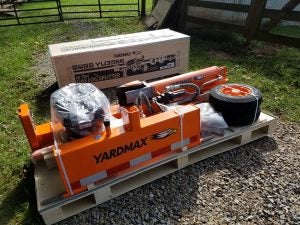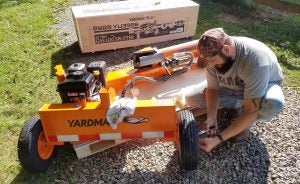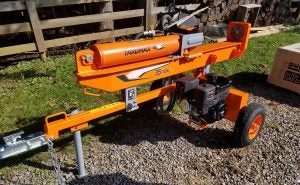It’s one thing to get to test a product in a controlled demo environment put on by the manufacturer; it’s a whole different game when you’re given free rein to put that product through the paces all on your own. That’s what happened when I got to bring YARDMAX‘s flagship log splitter to my little farm and see how it stood up to locust, white oak, pin oak, pear, and beech wood.
A few months ago, I got a sneak peek at the heavy-duty 25- to 35-ton splitters at an event in Milwaukee, and I touched on all of the patent-pending features and the enticing price point in that writeup. So I’m not going to spend much time covering that ground again. The quick recap, it has:
- A heavy-duty and unique U-beam design.
- A log spinner foot plate that easily rotates logs for splitting, reducing stress on the beam.
- A quick-connecting four-way wedge that helps to break logs into smaller pieces, such as for kindling.
Upon delivery, what’s instantly apparent is how much of a beast this splitter is, clocking in at 750 pounds per the freight paperwork. The next thing you’ll figure out is that there are parts of it that you need to assemble — and it’s pretty much a two-person job. I enlisted my neighbor, Dan, to help, and we found this YouTube video put out by YARDMAX to be quite helpful.

The process of putting the splitter together shouldn’t be difficult for anyone with a working knowledge of equipment — or bolts, ratchets, and wheels, for that matter. What’s most surprising is perhaps the weight. Sure, we expected the beam to be heavy, but when you unexpectedly realize that one piece is filled with hydraulic fluid, it definitely reminds you to lift with your legs, not with your back.
Still, if you have all the tools handy (I had everything except a 32 mm socket, but it was easy to improvise), the assembly shouldn’t take long.


Once everything was assembled, we moved the splitter to the wood shed and got to work on the wood. Everything I was splitting will be for either the 2017-18 or the 2018-19 winter. My family burns anywhere from two to three cords of wood a season, so planning ahead is crucial. And anyone who runs a wood stove or fireplace insert should understand how critical it is to season wood appropriately to cut down on creosote buildup (and chimney fires!).
It was finally time to give the YARDMAX a workout, and we certainly did that right out of the gate. We had a pile of wood ready and willing to be pulled apart. The splitter ran for well over an hour, tearing through piece after piece without a stutter. With the right size piece, I found the four-way attachment to be helpful for creating kindling (some pieces were too large to use that attachment on). Keeping a well ventilated area is a must, though I don’t suspect many people will be splitting wood out of their enclosed barn or garage.
The logs I was using were 16 inches long, optimal for my fireplace insert, but the length of the beam made it clear that much longer logs could be accommodated. There were lots of little wood chips and dislodged bark that are natural to the splitting process, but YARDMAX designed its machine to keep all of the key components protected from debris. I also loved having the cradles to catch the wood after splitting, which helped to cut down on the time it took to toss a finish log aside and move on to the next.
I’ve used the YARDMAX splitter several times since that first day, and there’s never a problem getting it started and tasking it for a day’s work. I’m enjoying having this tool around!



